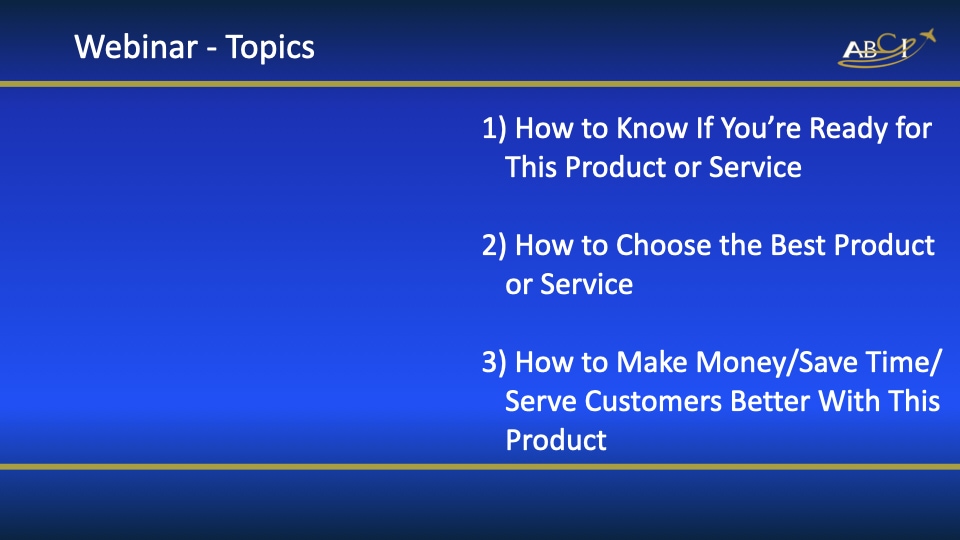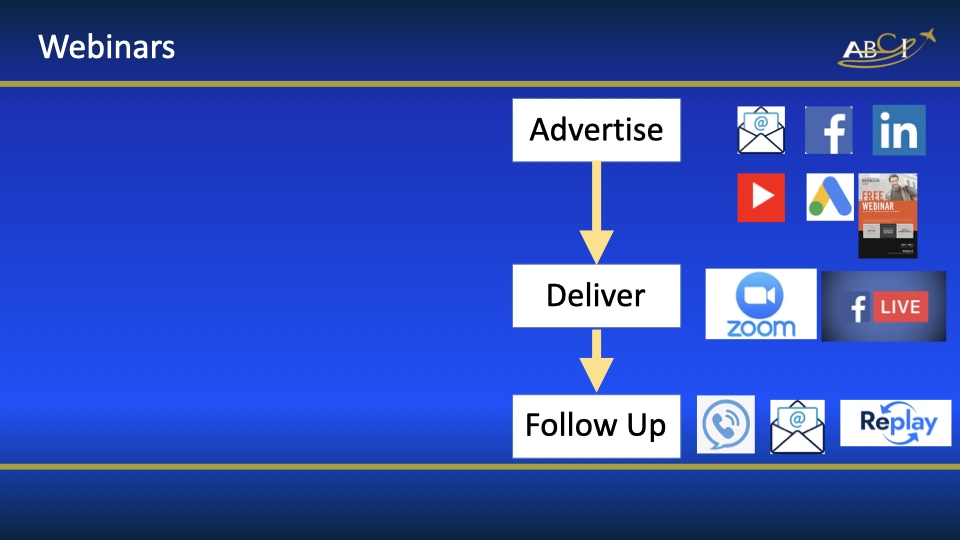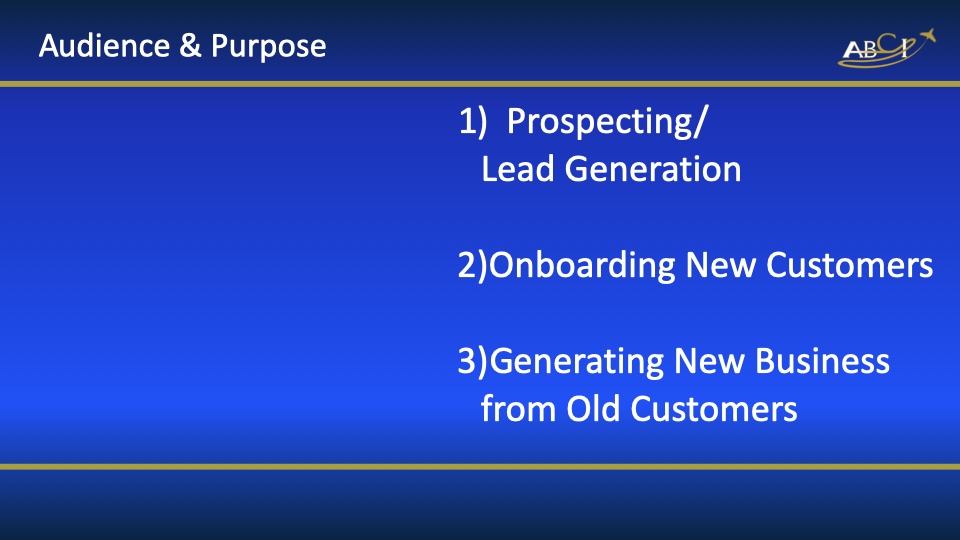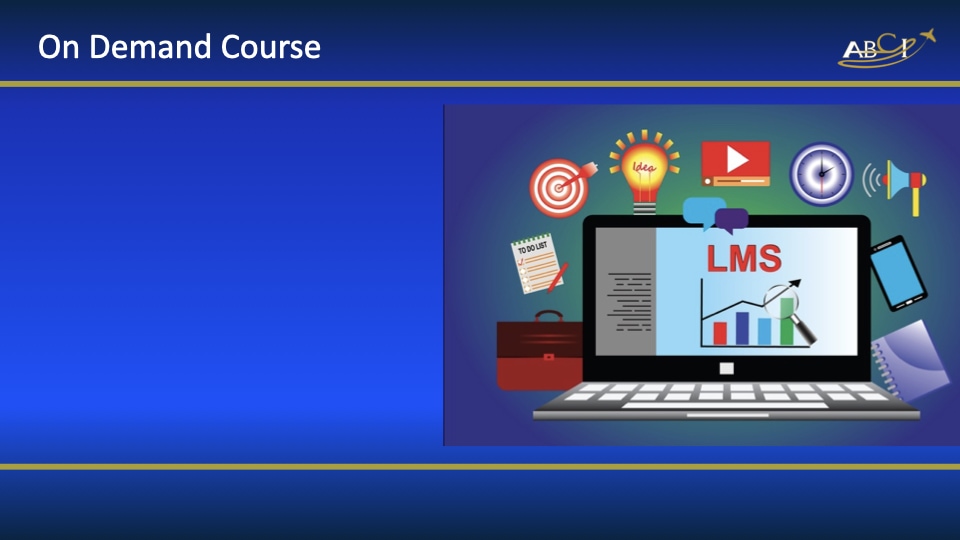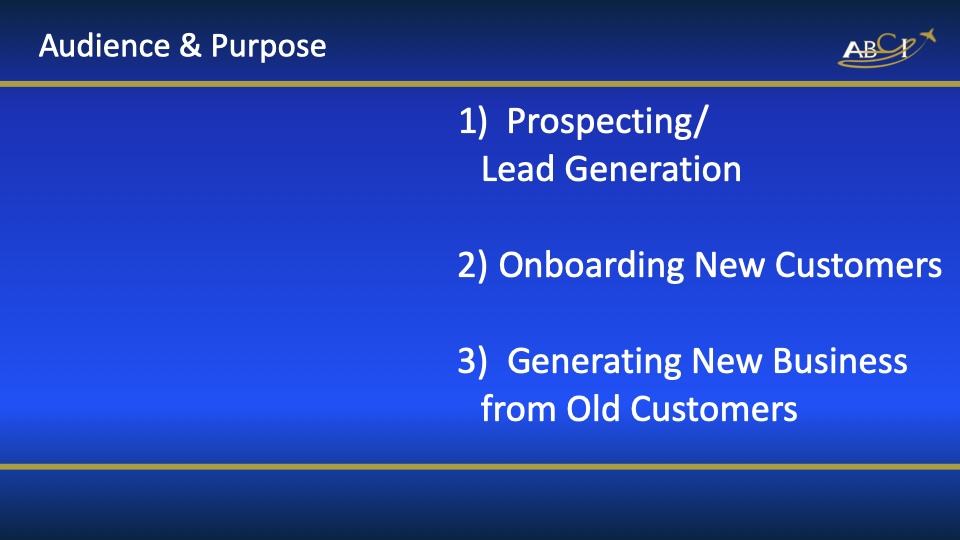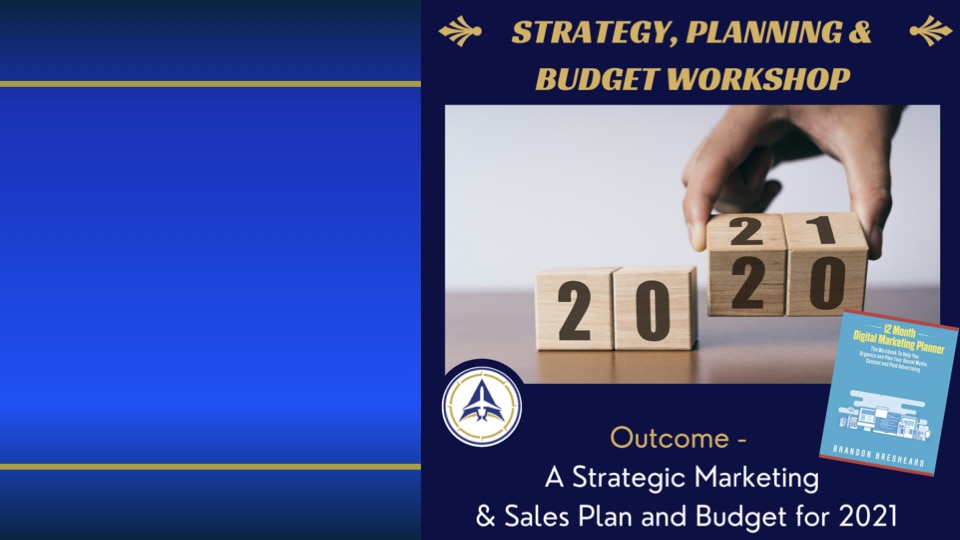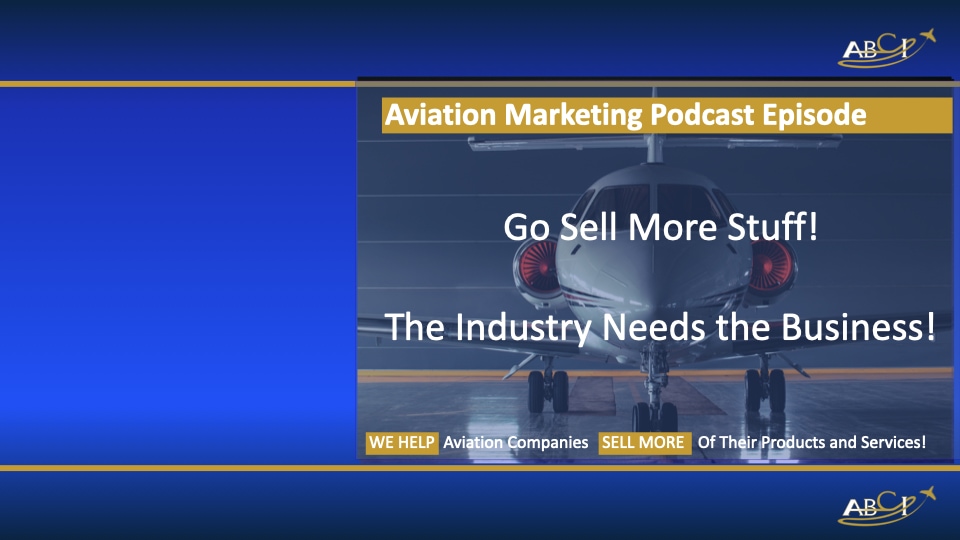We have to educate customers before they can make a good purchase decision, but aviation thought leaders are too busy to get them to sit down and listen to a lecture. What’s the best way to deliver it? The “old school” term for this is “content marketing.” Providing valuable information throughout the sales process.
But here, we’re deliberately talking about customer education because it makes it more intentional that’s what we’re doing. We’re not just pouring content on the prospect, we’re using interactive technology to help him or her get educated about the topic and the products and options available.
Educated customers make the best customers!
In this episode, John and I discuss three formats –
- “Tip of the Week” as emails and/or social media posts
- Webinars
- Short Courses
With the audience, purpose, and pros and cons for each.
What are YOU using to keep your customers educated and informed?
[embedyt] https://www.youtube.com/watch?v=H6KASwGZfAw[/embedyt]
Transcript – Three Ways to Deliver Customer Education to Make More Sales
Paula Williams: Hey, welcome to this week’s episode. This is the last in our series on customer education and why on Earth you would do that. Our first episode in the series was talking about if you are not convinced that you are in the education business, you really are. If you are in sales you are also an education. The second one was about different topics and different ways to apply that to your customer relationships and how to make that work. Today, we are actually getting into the specifics of three ways to provide customer education that improves sales.
John Williams: Exactly.
Paula Williams: Okay, so we are going to talk about — There are probably more ways to do this than we can shake a stick at. Some organizations have entire conferences with stacks of education sessions and all kinds of things providing education. But we are going to talk about three of the simplest and easiest to get started.
John Williams: At least expensive.
Paula Williams: At least expensive, exactly. Ways to provide customer education. So these are things that you could do starting next week if this is something that fits your business and your situation. So first one is a tip of the week or information snack [laughter], series of information snacks. The second one is webinars and the third is on-demand courses. So these are fairly simple and easy to implement and they apply pretty much across the board just about anybody who is in any kind of profession having to do with aviation can apply one or more of these methods, right?
John Williams: Yep.
Paula Williams: Okay. So first of all, what you need to think about is what is your most urgent audience and purpose? If it is prospecting and lead generation and you are going to do a slightly different version of this. Then, if your biggest or most urgent problem is onboarding new customers or if your biggest and most urgent problem is generating new business from old customers. Now if you have been in business for any length of time, I am going to suggest that your bias should be toward number three because for most of us, this is our fastest path to money [laughter] is by generating new business from old customers. It is so much easier to get more business from someone that already knows likes and trusts you than it is to acquire another new customer.
John Williams: Exactly.
Paula Williams: Okay, so to start with, let us start with the tip of the week. This is the simplest and easiest to start with and I cannot think of any business that could not benefit from putting a tip of the week out there. No matter how simple or how low budget you happen to be at the moment, we have all been there, right? So, you know, you can think of what are the things that people need to know about my product or service? What do we get the most questions about what do people have the most problems with?
Paula Williams: What are their biggest complaints and how can they be avoided? You know, you could sit there and brainstorm at least ten of these just by sitting down with a piece of paper, and then you could turn these into emails that go out once a week for the next ten weeks. And instantly, you have a customer education program that is going to help generate more sales or you know, you will have something that you can use to lead to generate leads by saying, you know, here are ten things you should know about this topic.
John Williams: And the customers that you have will say, you know, they because I know people are going to watch your product and they will say well he knows all about it when I get a tip all the time is really cool stuff. And you go talk to him about what you need.
Paula Williams: Yeah, he knows what he is talking about. He does it all the time. He is my reliable source of information about this topic. Okay, so a couple of things you could do it. Did you know, if you start a sentence with did you know, the rest of the sentence will probably write itself, right? Did you know you can also do this with our product or service did you know you can even do this with what we call interesting but useless facts.
Paula Williams: Did you know that a new one of these rolls off the assembly line every fifteen minutes [laughter]. Or there is almost always some kind of gee-whiz cool facts about this that you can mix in with your education to make it a little bit more fun and you can be as funny or as serious or as dry as you want to be and still be tolerable because this is just a simple short two or three sentence email, right?
John Williams: Yep.
Paula Williams: Okay. Another way to do this is here is a common problem, and how to fix it, or here is another way to get more value out of our product.
So, you know we found out that one of our customers was doing this. We had not thought of that. So, you know, here is another way that you could use this. Mike Patey, with Best Tugs, does an excellent job of this and he does really weird little videos of people doing strange things with his tugs, you know dressing up their grandkids is cowboys and putting them on the tug dressed up as a horse.
Paula Williams: You know, I mean, all kinds of crazy things that they do with these tugs, and he is got his fans trained to be sending this stuff in. So, you know, there is a lot of things that can kind of take on a life of their own. If you put yourself in the mindset of helping your customer get more value or enjoyment or fun out of your product, right?
John Williams: Yep.
Paula Williams: Okay. So the pros and cons of the tip of the week: They are short and interesting. They are easy to absorb and share to your point. You know, someone may want to just forward an email or a short little video to their friends, especially if it is funny they are very likely to do that. If it is just a short little bit of information or short little video you can use these for prospects or cut and or customers so, you know people who may not already be customers may still be interested in your tip of the week. The cons for these is that they can be shallow. You know, you are not going to make somebody an expert on your product or service by using a tip of the week.
John Williams: Yeah, but shallows okay in this case.
Paula Williams: Exactly, and they are also kind of hit or miss. So they are not comprehensive or systemic. So, you know people may or may not have seen any particular one.
John Williams: Or they may say, “Yeah, I knew that”.
Paula Williams: Exactly.
John Williams: But okay, they would not know the next one [laughter].
Paula Williams: Right. Great. So those are the pros and cons of the tip of the week, information snacks.
This is how you deliver them. Several different methods, right? The first one is to use email, the second is to use Facebook, the third is to use LinkedIn and of course, you could use TikTok. You could use any number of things. We are just using the ones that are the most popular in the aviation industry for aviation demographics. So Facebook, LinkedIn, YouTube, and I think I would actually go in that order. Of course, some are going to be better for one than another. So if you can do a video, by all means, use YouTube first, right?
John Williams: [laughter]
Paula Williams: If you are just going to do text tips, then an email to your list or you know, you may be able to split those up with Canva. Make them a little nicer or use a graphics program. You can send those to a graphic artist and get ten of them spiffed up a little bit, put together with some airplane clip art or you know, something like that to make them look really cool and put them on social media and get a little bit more attention out of them than you would just for a line of text.
Paula Williams: Okay, ways to make them a little bit more systemic and or automatic is if you are using email. Put them together in a list and put them into Mailchimp, or Constant Contact, or some kind of the system that will deliver them once a week. So you do not want to be typing this out and sending an email from your email, client on your computer once a week. Number one, that is not a good use of your time. Secondly, that is kind of illegal unless you have people that have opted into —
John Williams: Yeah.
Paula Williams: Your list. So just type them all out. You can spend maybe an hour in Mailchimp, or Constant Contact, and get them all scheduled as emails, or you can set them up so that after somebody requests your tips, or after you make a sale you can tag that person in Constant Contact or Mailchimp, or whatever to receive these tips once a week for the next ten weeks.
John Williams: Right.
Paula Williams: Okay, super easy. The next one, if you are using Facebook or LinkedIn, both of those media have groups and I would recommend that if you are selling to a particular type of person you can either use groups that are already there, or you can create your own group and then publish your tips in that group. So that those tips become another reason that they should join your group that has the added benefit of helping your customers get to know your other customers.
Paula Williams: Helping them see what your other customers are asking and getting involved in those conversations and other things. So it is a nice way to publish your tips and also build your community. Same thing with your YouTube channel. If someone subscribed to your channel on YouTube, then they will automatically get each additional video as you put them out. So some nifty ways to automate this process and make it a little bit less work and a little bit more fun more benefit everything else, right?
John Williams: Yep.
Paula Williams: Okay. Anything else you want to say about — I mean, how do you get tips of the week? I have seen people in the past do them on postcards, but —
John Williams: Yeah.
Paula Williams: I do not know. Do they?
John Williams: Nope.
Paula Williams: Nope. Okay, cool. All right. So once again your audience you want to think about your audience and purpose if your purpose is prospecting and lead generation, you are going to do a different type of tips of the week. You know how to choose a product or service. You know, how to choose the best of the options out there.
Paula Williams: How to solve this problem? How do you know if this person is a good fit for this product or service? And things like that. So that is one way of doing a tip of the week. If your onboarding new customers, then of course you are going to have a different set of questions. These are the first ten questions that people always have in their first ten weeks of using this product or service right?
John Williams: Yep.
Paula Williams: Okay. Generating new business from old customers, totally different set of tips. Here, you are going to want to talk about how and when to upgrade, how to intern for someone, you know other kinds of things. Reasons you want to refer to somebody, those kinds of things. So you can use any of those but you want to make sure that you keep those lists separate because you do not want to be driving people crazy with stuff that is not relevant to them.
John Williams: True.
Paula Williams: Okay. All right, so that is the tip of the week. Almost anybody can do that.
Webinars, a slightly smaller number of people can do this, but still, it is very useful and I think a lot of people that have not considered it should, for these reasons. Webinar topics, you could do — How do you know if you are ready for this product or service? How do you choose the best one? How to make money or save time or serve customers better? You know, whatever benefit is that your product or service provides by using this product.
Paula Williams: So those are topics that you could use to do a very popular webinar and the most important thing when you are doing a webinar is to have a good title and a good outcome. You are promising them something that is going to be worth an hour of their time. So, you know walking away with something that is, you know, you are going to save, you know, you could use a case study. This is how these FBOs saved a hundred thousand dollars a year by using our product. That is an outcome that you can promise using a webinar that would be very attractive to other FBOs.
Paula Williams: So use a case study, uses an example, use a that, you know, use lots of diagrams, use other things to make this really interesting. And you do want to promise it a good outcome because that is the most important thing to get people to actually accept your invitation.
So, the pros of webinars are that they are more popular than ever. Everybody is on Zoom. Even people who never heard the word Zoom a year ago are zooming like crazy every day of the week.
Paula Williams: And so they are really comfortable that comfortable with it. They can be very engaging, especially if you are a talented presenter. You can use the tools in a webinar to do a live chat. You can answer questions live. You can do a lot of things like that and they are very effective at making sales. The cons are they are time-consuming to set up and run and they also have very low attendance rates.
Paula Williams: Even the best webinars have a less than fifty percent show up the right of the people who have registered for the webinar. So, do not expect everybody who registers to attend and do not expect everyone that shows up to buy. But you know, those two things being said if you set expectations appropriately, they really are a pretty effective way to make sales. I have got products from webinars because they answered all my questions and they seemed to be very responsive and helpful people. You kind of get to know — [crosstalk]
John Williams: How are you happy with the product?
Paula Williams: Yeah.
John Williams: [laughter] Sure.
Paula Williams: In most cases, that is correct. I got a pretty good idea of how it worked. I got all my questions — [crosstalk]
John Williams: Did you ever buy a bad one?
Paula Williams: Did I ever buy a bad product from a webinar? Not that I can think of.
John Williams: Okay.
Paula Williams: You?
John Williams: No.
Paula Williams: Have you ever bought a product for a webinar?
John Williams: Nope.
Paula Williams: Okay.
John Williams: [laughter]
Paula Williams: Okay. Okay. So this is the process if you are doing a webinar. The first thing and not to be neglected and not trivial is to advertise your webinar.
John Williams: How far in advance?
Paula Williams: At least six weeks in advance. Just when you want to start advertising your webinar. People are so busy and there are so many demands on their time that you want to make sure that you are getting on people’s calendars and they are blocking out the time for you. And that is another reason. It has to be a big outcome or a big promise from that webinar. You can use email for this. You can use Facebook, LinkedIn, YouTube, Google Ads. You can do postcards, advertise webinars. There are lots of ways to advertise webinars, but the main thing does not to neglect this step or you will find yourself talking to an empty room, right?
John Williams: [laughter] Talking to yourself.
Paula Williams: [laughter] Talking to yourself. Right. That is never a good look. But weirdly you are going to have more people watch the replay of your if you do the ribbon webinar right, you are going to have more people watch the replay than actually attend live. And that is just a function of how many people are busy and can attend at a specific date and time. You can use Zoom [laughter], you can use Facebook live, you can use Google Hangouts. You can use GoToWebinar.
Paula Williams: There is a thing called WebinarJam and a bunch of other things that we have used the tool not as important as the content and the title and the promise and the outcome and the delivery. So there is a lot of things that are a thousand times more important than which platform should you use [laughter]. But there is a story about everybody always asks Lance Armstrong about the bike.
Paula Williams: What bike do you use? What tires do you use? What brakes do you use – all of those things? And his answer to this and he actually wrote a book entitled “It is not about the bike”, right? So it is the same thing with webinars. It is not about the webinar platform.
Paula Williams: It does not matter whether it is Zoom or Facebook live, you know, they all are varying degrees of frustrating and or buggy, you know, we have tried all of them. And they all have their pros and cons. We are using Zoom right now. And we really like it. I think you know, the only problem we have had with Zoom is the internet being patchy for us or any of the other presenters and that is something that Zoom cannot help. So, you know, we really cannot blame them.
John Williams: In which case they would have been the same way and no matter what your media.
Paula Williams: Exactly. So it is not about the bike [laughter]. To the platform that you are comfortable with learning all the buttons and whistles and everything else and just focuses on that advertising and the delivery. You are going to want to follow up after this. The most effective way is by phone like pick up the phone and call somebody. Dial their number and talk to them with your voice which is a weird thing these days [laughter], but it actually is the most effective way to follow-up.
Paula Williams: You can also follow up by email and what you want to do is really advertise that replay of the webinar because a lot of people intended to come and this happens to me all the time. I have intended to go to a webinar and something comes up or you know, if I have a webinar versus a customer on the phone was the question or a problem. I am going to take the customer with a question or a problem every single time and I think we are all in that same boat.
Paula Williams: So we play are really important and very popular and you will have more people watch your replay than actually watch the live webinar. So you want to make sure you are delivering that well.
Okay, so audience and purpose for webinars. You could do a webinar for prospecting and lead generation. If that is your most important problem at the moment and that would mostly be like that case study that we talked about. How can a prospect get this problem solved in the most affection — How can this customer? How can this prospect? Get this problem solved most effectively right?
John Williams: [laughter] Easy for you to say [laughter].
Paula Williams: I did not think. Well, I was going to cut that out then.
John Williams: Yeah.
Paula Williams: Okay. You can use a webinar to onboard new customers is be really great for a recorded webinar, or to do a webinar once a week for all of the new customer or once a month for all of the new customers that week or that month to get them on board, have an opportunity for them to ask questions, and to listen to each other’s questions too. Because often we learn more from questions other people are asking than we know would know to ask ourselves, right?
John Williams: Yep.
Paula Williams: Okay.
John Williams: Having your customers communicate with each other is not a bad thing.
Paula Williams: Exactly. And then the third audience and purpose here are to generate new business from old customers. So if you have an upgrade to your product or service and you want to roll that out, then a webinar is a great way to do that. Say have a free webinar for your existing customers about the upgrades and here is why you may or may not want to upgrade your product or service.
John Williams: Right.
Paula Williams: And you know, allow them to ask questions and everything else, and again you get that social proof of everybody talking to each other and everything else. So those are nice. 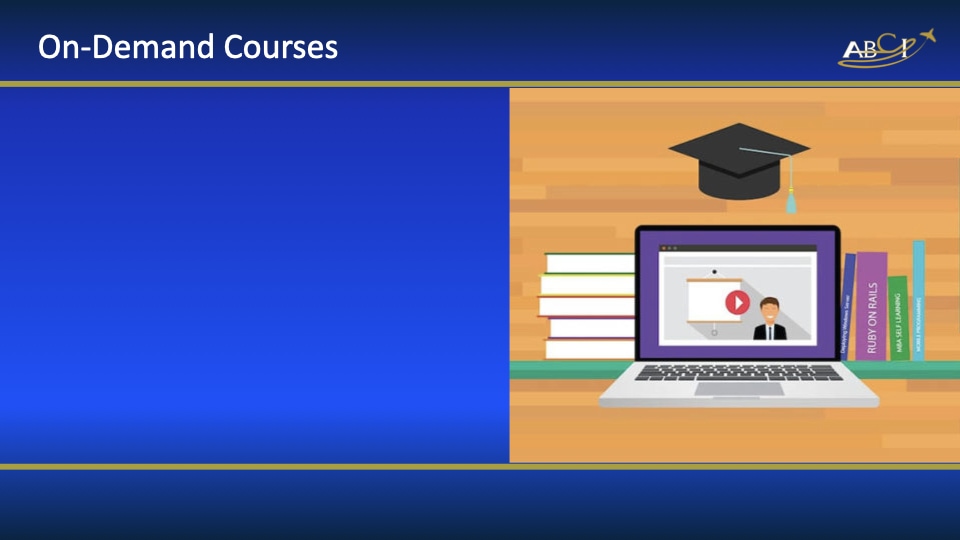
The third way of delivering customer education is an on-demand course and this is something that a lot of people have never considered because it was never something that we considered until fairly recently.
Paula Williams: And the reason is that it seems like a lot of work until recently there was not really the technology to do it very well. Most of the online courses or on-demand courses that were familiar with are terrible, you know, like the compliance courses that mandatory thing that you have to take if you work for a corporation and you have to do this once a year HR sponsored awful training and it is stock photography with some monotone reading things over and then a bunch of questions you have to answer, right?
John Williams: Yep.
Paula Williams: Are you have one in the even worse military you read a thing and answer the questions and —
John Williams: It is quite effective.
Paula Williams: Yeah.
John Williams: But boring.
Paula Williams: Not riveting [laughter]. Okay. Now nowadays, there are some ways to make this really really useful. You can do short little bits of video followed by some really interesting things like, you know, having people upload, you know, one of our lessons on one of our classes, we talked to them about how to leave a voicemail and then we have them leave their own voicemail and upload the audio file that they have created. So, you know, there are lots of things that you can do nowadays that you did not use to be able to make this interactive and to make it fun and to make it really useful for people because they are actually doing things.
Paula Williams: A lot of our courses are a hybrid of on-demand and live because we want to do some role-playing and things like that. So we do on-demand during the week and then once a week we meet, and then we do role-playing on the things that we learned in the on-demand course, you know by watching the videos and answering the questions and things like that. So, This is a really cool way of doing it because that course becomes kind of a nice little customer service portal for your clients. If you have got little two-minute videos on different topics, then they do not have to take the whole course.
Paula Williams: They can just go straight to the topic that they are most interested in. Watch a two-minute video and you know, maybe there is an activity or something that they can practice that or call you and you know, get some more information instead of a time or whatever. Depending on how you set up the course. Okay, so some on-demand courses that you could use: How to solve this problem, How to make more money?
Paula Williams: Save more time, serve more customers, or serve them better, how to get this benefit or outcome? So, you know, we use the example for a webinar. How these FBOs saved a hundred thousand dollars a year by using our product or service? That is exactly the sort of thing that you could do as an on-demand course except that instead of having to sit there for an hour or ninety minutes. This can be broken up into two-minute chunks. That they can take whatever they want and you know still get the benefit in the outcome, that they are after.
John Williams: Exactly.
Paula Williams: Okay. So the pros of on-demand content are they are convenient, they are engaging, they are effective, they are not time-consuming once it is built.
John Williams: [laughter]
Paula Williams: [laughter] Right? So you build it once and then as many people can take that as you like after the fact in you are not spending your time solving this problem every single time people are going to the portal and solving it themselves. You can offer certificates of completion if they meet certain qualifications if they have gone through all your materials. You may be able to offer PDUs or CEUs for the NBAA camp program or the PMI project management institutes. PMP program requires a certain number of hours every three years in the case of PMI, which is really kind of bizarre because you forget about it in that amount of time, and then all of a sudden you need a bunch of PDUs.
Paula Williams: So you can offer that, you know, you can get your course approved for that sort of thing. The cons really the only con is the initial setup. It does take some time to record those two-minute videos and to get them all lined up and to get your course built and tested. So that being said, what they have now is learning management systems, and their thousand of times better than they were ten years ago.
Paula Williams: When I was at Wells Fargo taking their HR required “Thou shalt do this, thou shalt not do that”. This is how you register for your insurance. This is how you do all your stuff, those types of courses. So what these courses offer and we have invested pretty heavily in a learning management portal that we are using for ourselves and for courses that we built for clients and they have the ability to serve videos. You can actually require that they watch the video before they progress, right?
John Williams: Yeah.
Paula Williams: They have assignments that can be multiple choice or an essay or quizzes and things like that or assignments that they have to upload and that you have to look at an approved before they can can carry on. They have automatic engagement so that it is what they call gamification. So, you know after they complete a certain number of activities and they unlock a new level kind of a situation. You can also drip courses. So, you know, this happens in the first week. These courses become available in the second week.
Paula Williams: These become available in the third week and so on. There is a forum so that your students in your course can talk to one another. You know, I just see each other’s answers in that course and not be out on social media if you do not want that they offer all kinds of metrics and other things that are really nice and also you can charge money for these courses. If you have one that has a high value objective in a high-value outcome, then you can charge money for this they pay you, they have access to the course. It gets delivered on schedule you get regular reports of how people are doing and you carry on with your day job. Yeah with a second source of income.
John Williams: Right.
Paula Williams: Yeah. So in a lot of companies actually use education as another Revenue Center. You know, this is another way that they can earn money and also promote their products and services. So, you know, those are our possibilities that would really love to have you think about and explore. Okay. So once again, you can use these for prospecting and lead generation. These would probably be a free course that you would use maybe not depending on the outcome that you are offering.
Paula Williams: You may want to charge something for that because you know, the philosophy is basically if someone has paid for something, they are more likely to take it seriously. So if you have a really good outcome in your offering really high value, high-quality education, then, of course, you can charge money for that onboarding new customers. So this is something that you can offer that will differentiate your products from those of your competitors. If you have an onboarding training sequence or something like that so that their team can get certified and how to use your new piece of equipment or other thing.
Paula Williams: You can offer training that is designed for the flight crew. So, you know your dispatcher, your chief pilot, your technicians, and other things will probably need to know some things about your new airplane that they do not know already. So if you can offer some kind of onboarding that is specific to that person’s role so that they can get up to speed then the owners going to get a whole lot more value out of that airplane, right? Okay. Generating new business from old customers so you can an old dog new tricks, right?
Paula Williams: You know, somebody is been with you for years and has been using the same product or service. You have to remember that. Your competitors are approaching them all the time. So, you know, you do need to make sure that your product is fresh and new and that they are getting some value out of it. So you may want to do something like an annual seminar of here is what is going on in the aviation market and here is how this impacts your use of this product, or service, or you know, your business and this is how we can help you with these factors that have come up this year. So, you know that just shows that you care about your customers and it will keep them as customers instead of getting tempted away by some horrible competitor.
John Williams: [laughter]
Paula Williams: [laughter] Who is going to not serve them as well as you can. All right, so we have been doing this. We are offering more value to the people in our marketing lab by providing these workshops, and what it does is allows me to magnify my time. So we, you know, people get a certain number of office hours, but if they can get some additional benefit from that on their own time, you know, they want to learn about something at four o’clock in the morning and I do not want to be up on the phone with them walking them through it. They can go straight to our materials, watch some two-minute videos and learn some stuff about how to set up their budget, or how to set up a strategy, or how to set up a Google Ad, or whatever.
Paula Williams: And you know, then they get more benefit out of their relationship with us and I get more sleep. So everybody wins, right? Okay, and then I also have these workshops that we sell. That being said, this episode is being brought to you by our strategy planning and budget workshop. The outcome of this workshop is a strategic marketing and sales plan and budget for 2021. So you probably know someone or are someone who is in the throes right now of coming up with a great sales plan and budget for 2021 and if you are starting with a blank sheet of paper, you are not doing yourself any favors because that is hard.
Paula Williams: So if you are starting with some templates that you know work for other aviation companies and that, you know have been working what we have been using with clients for a number of years and have learned some of the do’s and don’ts and in and the out, some of these things. You can start with some great templates and some great videos and some great materials. It comes with a twelve-month digital marketing planner, which is a hard copybook. It comes with our calendar and our social media guide for aviation salespeople.
Paula Williams: So we would love to have you join us in that workshop. We would also love to have you join us if you are in sales, in our sales basics course which starts January 11th. And if you want to do both, you can get five hundred dollars off of the bundle, when you buy them together before the end of the year. So if not, you know, if you are one or the other that is perfectly fine. I know, you know, some people do sales and marketing. Some people do marketing and sales.
John Williams: And most people wear two hats.
Paula Williams: A lot of people wear two hats these days, especially now, right? Yeah. All right, so go sell more stuff.
John Williams: The industry and America need a business.
Paula Williams: Absolutely. So we will see you next week.
John Williams: Stay safe and happy.
[END]
Podcast: Play in new window | Download
Subscribe: Spotify | Amazon Music | RSS









